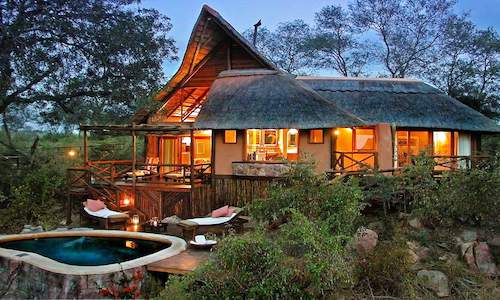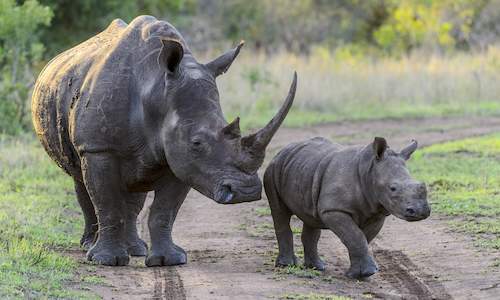
Name
Black Rhinoceros [Diceros bicornis sp - numerous sub-species in Africa]Appearance
Bulls weigh up to 1 200 Kg and cows about 800 Kg. As such this species is smaller than the White Rhino. It can further be distinguished from the White (or square-lipped) Rhino by the pointed upper-lip. Other than the White Rhino, the smaller head is usually held high. The ears are trumpet-like and more rounded. The soil in which it rolls, partly determines the skin colour.Diet

Behaviour
Running, it can attain a speed of up to 55 km/h. White Rhino dung middens are sometimes covered by the Black Rhino with it's own dung. Size of bull territories are largely determined by the availability of food and water supply. Young bulls straying into the territories of dominant bulls may be killed. Bulls are solitary, and will only spend time with a female in an oestrus cycle.Breeding

Where Black Rhino Are Found
The African population declined from about 65 000 in 1970 to a mere 2 400 in 1995, when the last count was conducted. Most of the world's Black Rhino population occurs in South Africa, Namibia, Kenya and Zimbabwe.
The Black Rhino species is now considered to be seriously threatened. Complicating conservation efforts, is the fact that four subspecies are acknowledged within the distribution range of the Black Rhino. Of D.b. bicornis, small populations are re-established in southwestern South Africa, of D.b. michaeli, a trans-located population is established in the Addo Elephant National Park, South Africa. D.b minor occurs in the northern and eastern parts of South Africa.
Field Notes
The rhinos of Africa are in another stage of decimation with the rhino horn trade sky-rocketing, and the price of Rhino Horn becoming more valuable than cocaine. The cause of this is the mistaken belief in the East that the horn is a powerful aphrodisiac and enhancer. The trade is not going to stop until the attitudes are changed in the East, despite the ideas of the general public and conservationists.Black Rhino Poaching
The Black Rhino is on the Critically Endangered Species list. See more Rhino poaching statistics
Where is the Best Place to See Black Rhino in Kruger National Park?
The best place to see Black Rhino in Kruger National Park is at Lukimbi Safari Lodge - the area is home to endangered black and white rhino.

 Indulge in grandeur at Lukimbi Safari Lodge, combining luxury and adventure in Kruger National Park's Lwakahle Concession....
Indulge in grandeur at Lukimbi Safari Lodge, combining luxury and adventure in Kruger National Park's Lwakahle Concession.... The White Rhino is the third largest land mammal. Massive, stocky, and with a reputation of being not quite as aggressive as the black rhino...
The White Rhino is the third largest land mammal. Massive, stocky, and with a reputation of being not quite as aggressive as the black rhino...